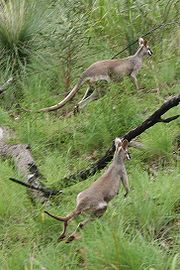
Whiptail Wallaby
Encyclopedia
The Whiptail Wallaby also known as the Pretty-faced Wallaby, is a species of wallaby
found in eastern Australia
. It is locally common from Cooktown
in Queensland
to near Grafton
in New South Wales
.
 The Whiptail Wallaby lives in grasslands and woodlands particularly on hills or slopes. It is primarily a grazer. In grasslands, the wallaby primarily eats kangaroo grass. It also eats monocots in nearby creeks. It is primarily a diurnal species. It is active in the morning and late in the afternoon but continues into “to an unknown extent during the night”.
The Whiptail Wallaby lives in grasslands and woodlands particularly on hills or slopes. It is primarily a grazer. In grasslands, the wallaby primarily eats kangaroo grass. It also eats monocots in nearby creeks. It is primarily a diurnal species. It is active in the morning and late in the afternoon but continues into “to an unknown extent during the night”.
Joeys stay in their mother’s pouches for the first nine months. When they leave will they will still stay with them for up to 18 months. Whiptail joeys follow their mother continuously and do not hide in vegetation. Subadult male wallabies sometimes leave their natal groups.
Wallaby
A wallaby is any of about thirty species of macropod . It is an informal designation generally used for any macropod that is smaller than a kangaroo or wallaroo that has not been given some other name.-Overview:...
found in eastern Australia
Australia
Australia , officially the Commonwealth of Australia, is a country in the Southern Hemisphere comprising the mainland of the Australian continent, the island of Tasmania, and numerous smaller islands in the Indian and Pacific Oceans. It is the world's sixth-largest country by total area...
. It is locally common from Cooktown
Cooktown, Queensland
Cooktown is a small town located at the mouth of the Endeavour River, on Cape York Peninsula in Far North Queensland where James Cook beached his ship, the Endeavour, for repairs in 1770. At the 2006 census, Cooktown had a population of 1,336...
in Queensland
Queensland
Queensland is a state of Australia, occupying the north-eastern section of the mainland continent. It is bordered by the Northern Territory, South Australia and New South Wales to the west, south-west and south respectively. To the east, Queensland is bordered by the Coral Sea and Pacific Ocean...
to near Grafton
Grafton, New South Wales
The city of Grafton is the commercial hub of the Clarence River Valley. Established in 1851, Grafton features many historic buildings and tree-lined streets. Located approximately 630 kilometres north of Sydney and 340 km south of Brisbane, Grafton and the Clarence Valley can be reached...
in New South Wales
New South Wales
New South Wales is a state of :Australia, located in the east of the country. It is bordered by Queensland, Victoria and South Australia to the north, south and west respectively. To the east, the state is bordered by the Tasman Sea, which forms part of the Pacific Ocean. New South Wales...
.
Description
The Pretty-faced Wallaby is distinguished by its paler colouring and white stripe under its face. Their faces have a chocolate-brown fur covering their muzzle. They are black and white on its chest and the rest is grey to brown fur. Males weigh from 14 to 26 kilograms and stand at a height from 70 to 93 cm. Females weigh from 7 to 15 kilograms and stand at a height from 65 to 75 cm.Lifestyle

Social behavior
The Whiptail Wallaby is a sociable species, sometimes coming together in mobs of up to 50. They live in a home range of up to 110 hectares. The mob usually gathers in the afternoon during feeding. Some home ranges may overlap with others and the member of the mob take turns resting and guarding. The mobs contain all ages and sexes throughout the year, but seldom if ever were all members of a mob together at one time. Mobs often split into continually changing subgroups of fewer than ten animals. Wallaby mobs have a linear hierarchy that is determined by ritualized “pawing” which is non-violent. They may also pull grass. Wallabies will cough to show submission. These bouts function only to determine access to oestrous females.Reproduction
The most dominant males mate with the females. A male will wander though a gathering of female stiffing their cloacae and tasting their urine. When a male finds a female close to estrous, he stays with her. However before she enters estrous, he may be replaced by a more dominant male. The estrous cycle for a Whiptail Wallaby lasts for only 42 days.Joeys stay in their mother’s pouches for the first nine months. When they leave will they will still stay with them for up to 18 months. Whiptail joeys follow their mother continuously and do not hide in vegetation. Subadult male wallabies sometimes leave their natal groups.

